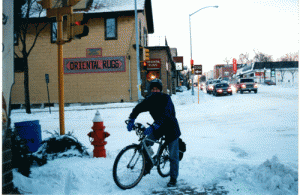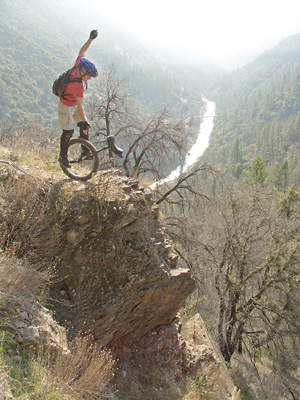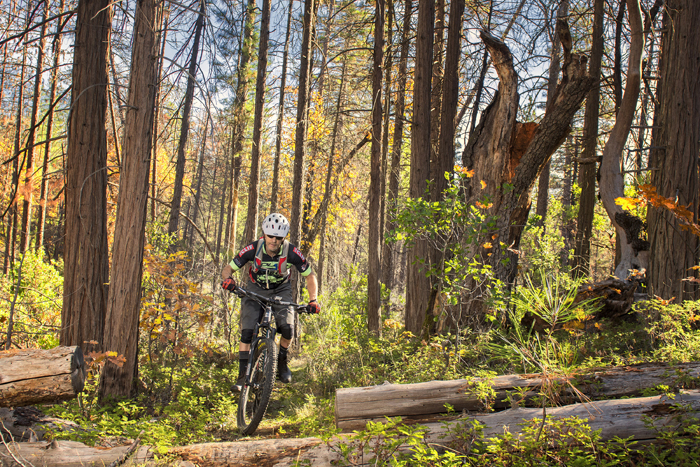- Paddling My Own Canoe - 10/01/2018
- West Coast Board Riders Club - 10/01/2018
- Never Too Oldfor Gold - 07/29/2018
Survival tips for commuting through the wet, cold and dark season
Story and photos by Haven Livingston
There’s no need to pack away your trusty two-wheeled steed just because a little rain starts to fall or a few inches of snow lie between your wheels and the ground. For some people, and you could soon be one of them, this is when the fun begins. Winter bike riding and commuting requires a little more preparation and perhaps motivation, but trust me, you’ll feel more badass than ever when you show up for work with frozen eyelashes and your coworkers envy your toughness. If you want to be pragmatic about it, consider that you’ll save on gas, be environmentally friendly and keep your fitness up while everyone else puts on holiday pounds.
Brian Nakagawa, bike mechanic at Olympic Bike Shop in Tahoe City, has been bike commuting year-round in Tahoe for the past 14 years. According to Nakagawa, people who commute regularly and maintain their bikes shouldn’t have to make too many changes to their routine, but those who are just starting out might want to tweak a few things on their bike and cherry pick the days they ride. “Just because the calendar says winter, doesn’t mean every day will be winter-like. Tahoe roads are at least plowed, if not dry, on most winter days,” he explains.
Generally speaking, there are three things to consider when the calendar flips to the dark side: a properly equipped bike, the right clothing, and riding tactics that will increase safety during your commute.
Pimp your ride
Winter riding introduces all kinds of crud to your bike, and freezing temps are tough on standard gears, cables, and derailleurs. Single speed bikes with fewer moving parts are one solution.
Beyond this, adding fenders to your wheels is an excellent first step in preparing your bike for winter rides. They protect your bike (and you) from crud accumulation when roads are wet and slushy. Also, if snow and ice are part of your daily winter diet, studded tires will be your best friends. They will save you from embarrassing and painful slide outs on black ice and undoubtedly make you feel burly.
Even with the right equipment, there is no substitute for regular bike maintenance. Take time on warmer days to wash your bike and re-lube it with a non-wax based lubricant. Keep in mind that these “wet” lubes require you to clean your drive train more often because they pick up more grit than the wax based lubes, which are more suitable for dry, summer riding. Also, make sure to store your bike somewhere warm so water doesn’t freeze around moving parts. Check your breaks and gear shifters before every ride to make sure water hasn’t frozen inside the cable housing.
Finally, add lights on the front and back of your bike for lower light conditions and night riding.
Dress to impress
You’re not going to win any runway contests following these three clothing rules, but they may save your life: bright, windproof, full coverage. Beating the wind chill factor and keeping skin covered are the keys to staying comfortable, especially for extremities. Goggles, wind proof facemasks, mittens and a cap that fits under a helmet are essential. Layering let’s you adjust your temperature easily and you will probably need some waterproof outerwear. Consider replacing clipless pedals with platform pedals so you can wear warm boots.
Defensive driving
Motorists don’t always expect bikes on the road in winter. Ride defensively and know your braking distance in different road conditions. If your summertime route follows major streets, look around for alternatives. Most cities with bike paths plow them when it snows, making them the safest routes.
Always assume drivers can’t see you. In wet, dark, or snowy conditions, this is all too often the case. If you see a car driving down the road with fogged up windows, consider that a red flag. Just because someone has a driver’s license, doesn’t mean they have a clue about winter driving. People who drive cars without properly defrosted windows are like an accident waiting to happen, and a real concern for bike commuters.
On the positive side, winter bike commuting requires extra care and knowledge, but the payoff is well worth it. As winter weather leads more people to get in their cars, traffic gets worse, which adds extra appeal to alternative modes of transportation. Properly equipped, you too can be dry, warm and humming passed cars stopped in traffic on your way to work. When you arrive, exhilarated by the cold air, you can bask in the glow of your accomplishment.














